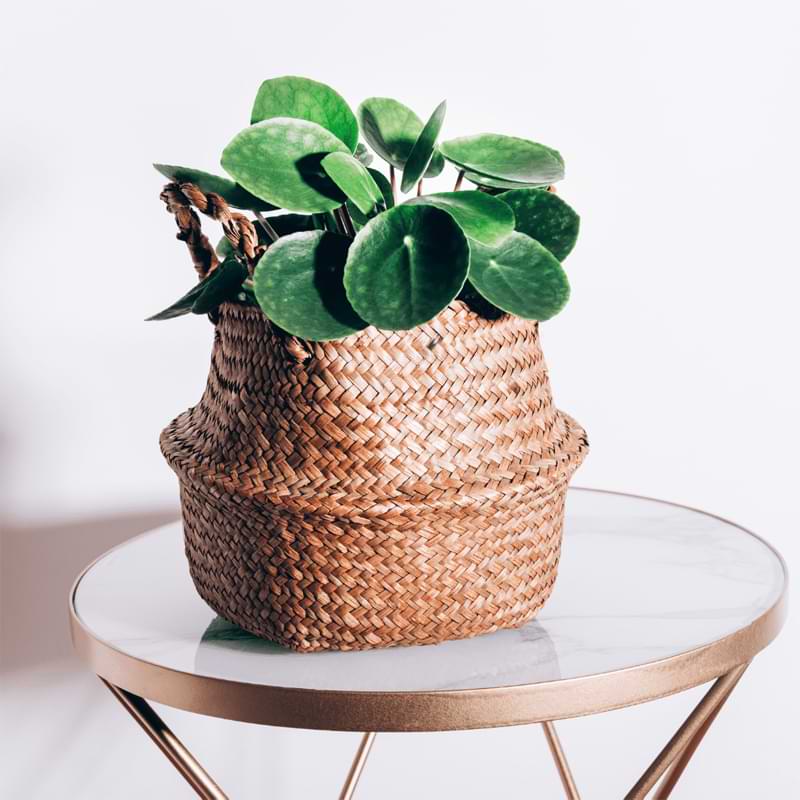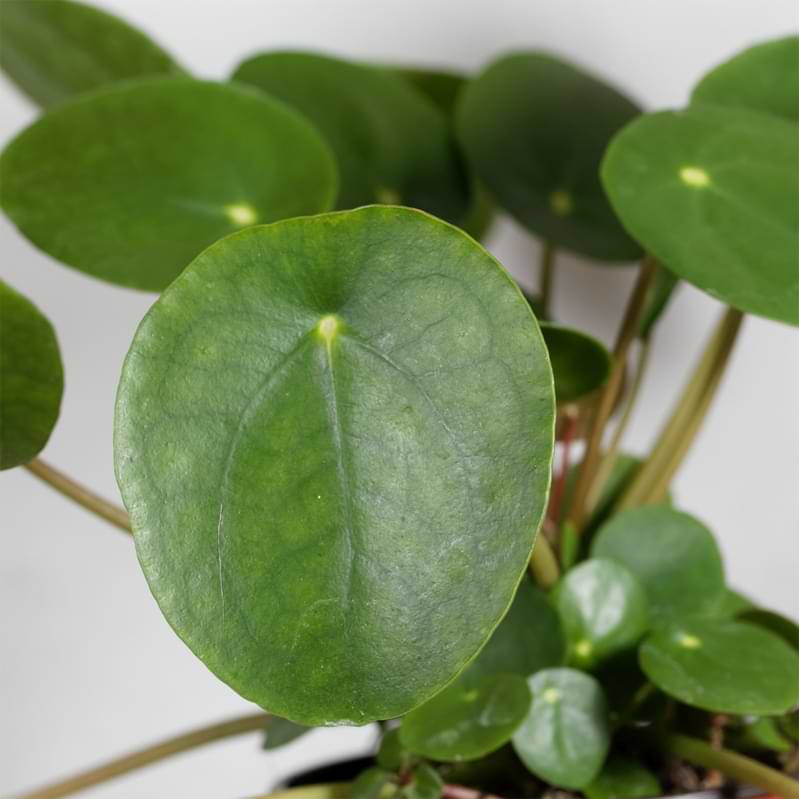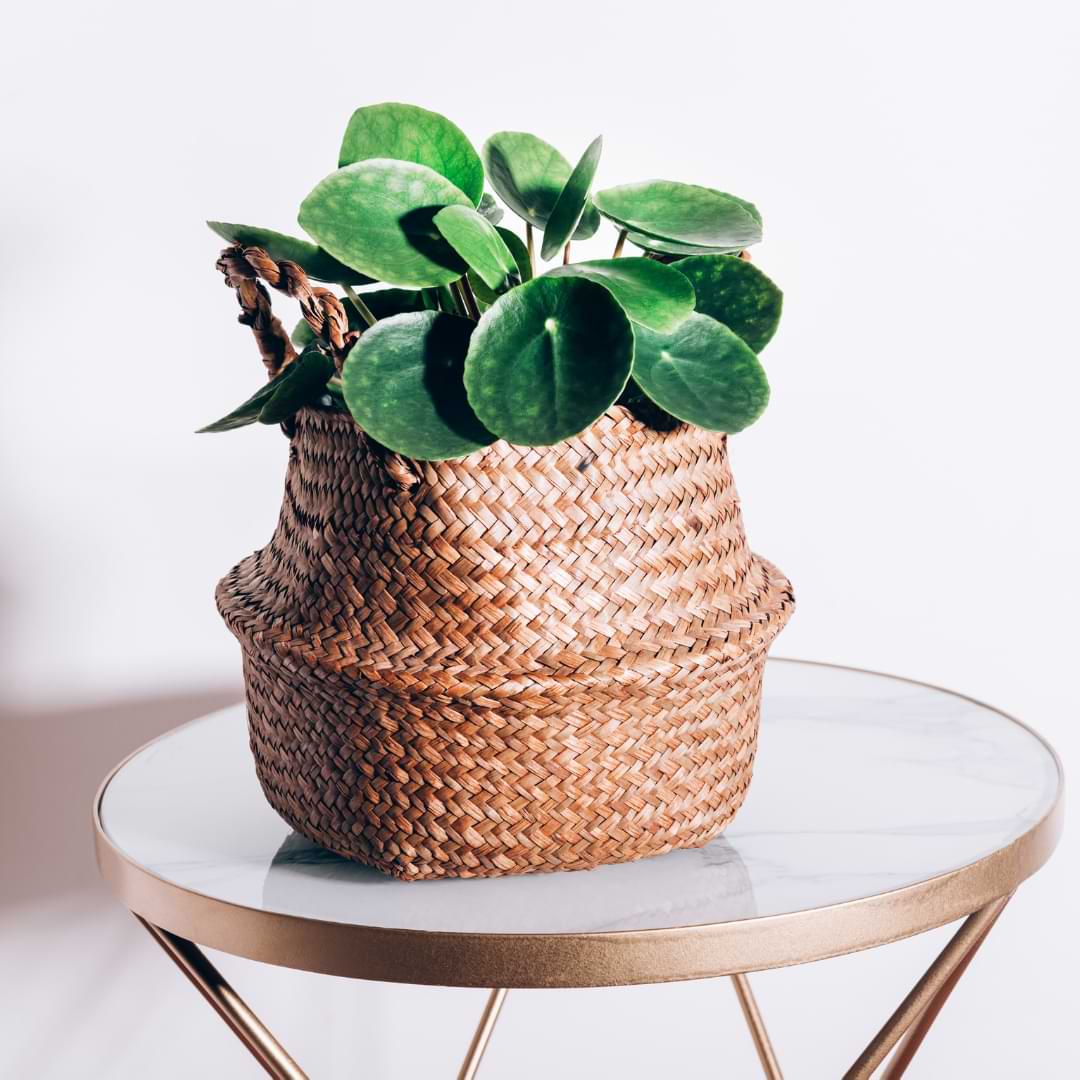In this article, we’ll walk you through everything you need to know about how to propagate the Chinese money plant.
The Chinese money plant, or Pilea peperomioides, is beloved for its round, coin-like leaves, which is how it gets its nickname. However, it can be hard to find these plants in gardening stores, and their delicate stems and leaves can make shipping from online sellers a hit or a miss. For the frugal and practical houseplant lover, learning how to propagate the Chinese money plant can come in handy.
Propagating your Chinese money plant is also a great way to generate the perfect gifts for your houseplant-loving friends.
In this article, we’ll walk you through everything you need to know about propagating the Chinese money plant.

Table of Contents
About Chinese Money Plant (Pilea peperomioides)
Pilea peperomioides goes by many names, including the Chinese money plant, missionary plant, UFO plant, or pancake plant; also, very often it’s simply called a pilea. It’s not the only pilea species out there, but it is the most popular, so often when someone says “pilea,” they’re talking about Pilea peperomioides.
This plant is native to the southwestern region of China and was supposedly introduced to the Western world by a Scandinavian missionary who took home cuttings to share with his friends.
This perky plant is best suited for intermediate houseplant parents who have some experience with other indoor plants. While this plant isn’t particularly difficult to care for, it doesn’t recover from issues super quickly, so it can help to have a little houseplant background before you jump into the pilea pool!
Chinese Money Plant Propagation
Propagating the Chinese money plant is quite simple. You can propagate by rooting stem cuttings in soil or water or by repotting plantlets (or “pups”) that the plant naturally produces to propagate itself.
We’ll walk you through these different methods so you can choose the right one for you and grow your houseplant collection on the cheap!
How to Take a Chinese Money Plant Cutting
The best time to propagate a Chinese money plant with cuttings is in the spring when the plant is most likely to be actively growing. This will give your cutting a boost of growth hormones that will increase your chances of propagating successfully!
To take a cutting, locate a healthy, fairly young section stem that includes at least one or two leaves. Using clean scissors or shears, cut the stem a few inches below the leaves so that you have a nice, long stem.
Propagating From Stem Cuttings
This is a good way to propagate your Chinese money plant before it has produced offshoots, and also a great way to use cuttings after pruning your plant (more on this later).
Instructions
After you’ve taken your cutting, put it upright in a clear glass container of water with a little Propagation Promoter mixed in. (This will encourage rooting and prevent infection.) Make sure the cut end is completely submerged in the water, but that the leaves aren’t touching the water at all. Purified, distilled, or rainwater works best, but you can also use tap water that you’ve set out overnight or for at least 8 hours to allow the chlorine to evaporate. Some plants and cuttings can be sensitive to the chemicals in tap water.
Place the container in a bright place but not in direct sunlight. Make sure to keep the water topped off, and completely change the water every week.
Within a couple of weeks, you should see some new baby roots starting to form! After a month or two, these roots should be about an inch long and ready to plant in soil.
Propagating From Root Plantlets
Most Chinese money plant owners prefer to propagate their plants using this method because it’s so easy! This method takes advantage of the plant’s own propagation efforts, so all you have to do is finish what the plant already started.
Instructions
First, locate a plantlet (or offshoot, pup, whatever you want to call it) growing from the plant’s root system. You might need to brush some dirt out of the way so you can see where the shoots are coming from, but they’ll usually be easy to spot because they’ll look like mini Chinese money plants sprouting off the main mother plant.
Once you find a mini money plant with some leaves on it, locate the spot where it connects to the mother plant’s root system, and use clean scissors, shears, or a knife to cut it off.
Like a stem cutting, you can then place the pup in a glass of clean water and Propagation Promoter, then stick it in a bright place and wait for roots!
You can also plant the offshoot directly into soil. To do this, fill a small container that has drainage holes (it could be as simple as a yogurt cup with some holes cut in the bottom) with a little potting mix. Stick the cut end of the pup into the soil, and push it down deep enough that the plant can support itself and stand up straight. Water thoroughly, and it’s a good idea to include some Propagation Promoter in the water. (We love this stuff, can’t you tell?)
Place in a bright place or, better yet, under some full-spectrum lights. Keep the potting mix consistently moist but not soaked or soggy. You can also place some plastic wrap loosely over the top to lock in humidity, if you want.
These steps will help increase your chances of your pup taking root, but a lot of Chinese money plant owners have great luck just sticking the pup directly into soil in a planter and keeping it well-watered for a while. Simple!
Within a couple of months, your pups should have grown some roots of their own and can now be transplanted into planters!
Propagating From Stem Plantlets
Stem plantlets are essentially the same as root offshoots, except they sprout from the main stem of the Chinese money plant rather than from the root system.
These will look like mini Chinese money plants growing from the main stem of the mother plant. Once these have a few leaves of their own, they can be removed for propagation.
Instructions
Locate one of these plantlets and use a sterilized knife, shears, or scissors to cut it off the stem.
You can then place the pup in water or soil as we explained earlier. Easy!
Propagate When Chinese Money Plants Are Leggy
Chinese money plants can get leggy if they aren’t getting enough sunlight, and this can be a great time to take cuttings for propagation, since cutting the plants back and letting them regrow properly is the only way to fix legginess. Talk about making the best of a bad situation!
Older sections of the plant may be harder to propagate because they might not be growing actively, but it’s worth a shot, especially if you’re pruning them anyway.
Here are a few tips to increase your chances of getting your leggy props to take root:
- Make sure the section has at least one healthy leaf and a few inches of bare stem. (If your plant’s really leggy, this should be easy!)
- Prune the plant in the spring when the plant should be actively growing.
- Use a rooting hormone like Propagation Promoter to encourage the cuttings to root.
Care After Propagation
While it’s important to take a viable cutting or offshoot and set it up correctly to allow it to root, a big part of propagation success is caring for your plant after it’s taken root. New Chinese money plants need the right care to grow up into big, beautiful, mature plants!
Here’s how to care for your baby Chinese money plants after propagation.
Light
You can start your propagations in the light conditions a mature Chinese money plant would enjoy.
Pilea plants do best in bright, indirect sunlight for most of the day, but they don’t tolerate much direct sun. A little morning sun won’t hurt, but direct sunlight after 10:00 a.m. or so can scorch the leaves!
An east-facing window is your best bet. A south- or west-facing window might also work as long as you scoot the plant back far enough that the sun won’t fall right on the leaves, or if you filter the light with a sheer curtain.
If you can’t provide enough natural light, you can use full-spectrum grow lights for up to 12 hours per day.
Temperature & Humidity
Unlike many houseplants, the Chinese money plant can actually tolerate some colder temperatures. (Cooler temperatures for a few weeks might also encourage flowering!) Otherwise, this plant will be happy in regular room temperatures.
If it gets cold in your home, this might be a good plant for you! Still, it’s best to avoid placing your plant near strong drafts. You may want to keep your baby Chinese money plant in stable room temperatures until it is more established, with a strong root system and new leaves.
This plant likes fairly humid conditions, especially when it’s young and the leaves are the most delicate. If you’re propagating in soil, putting plastic wrap or a plastic bag over the soil can lock in humidity.
Once you’ve planted a propagation or once your plant is established, it will appreciate some additional humidity from other plants, a humidifier, or a humidity tray.
Soil Conditions
Plant your propagations in well-draining soil and a container with drainage holes. Our Premium Potting Soil for Indoor Plants is a great choice because it balances moisture retention with drainage, thanks to ingredients like coco coir, orchid bark, perlite, and organic green waste compost.
Watering
For mature Chinese money plants, you should water when the soil is mostly dry. (The top half should feel dry to the touch, or a moisture meter should read about 2.)
For your baby Chinese money plant propagations, it’s a good idea to keep the soil a little more moist while they get established. Water when the top few inches feel dry or when a moisture meter reads 3-4.
If the stems get droopy, that’s a sure sign that your pilea—mature or freshly propagated—wants a drink!
Fertilizer
You should wait a few months after planting your propagations before you start fertilizing. Once the plant has grown a robust root system and has started to grow new leaves, you can use a gentle liquid fertilizer once or twice a month during the spring and summer.
Indoor Plant Food is a great choice for pilea plants of any age.

Common Problems After Propagation
You might run into problems after you propagate your Chinese money plant. Sometimes this is just bad luck. Propagating is risky business, after all, and success is never guaranteed. But sometimes you can treat problems and save your cutting or plantlet.
Here are some common issues you might run into.
Leaf Discoloration
The leaves on your cutting or offshoot might turn yellow or various shades of brown. Sometimes this is unavoidable. This is one reason why it’s good to take a cutting with a few leaves because sometimes one leaf will start to turn while the rest remain healthy.
If you notice discoloration, change the water, rinse the roots or the cut end, and clean the container. You may also want to remove the affected leaf to give the others a better shot at survival.
Drooping Leaves
If the leaves on your propagation start to droop, it could simply be in shock. This isn’t uncommon when a plant experiences a trauma such as being pruned or moved.
If your plant is in water, leave it alone. It might pull through on its own.
If you’ve already planted your propagation in soil, make sure the potting substrate hasn’t dried out.
Curled Leaves
If your plant’s leaves are curling, it might want more humidity. Set up a humidifier nearby, place the plant on a humidity tray, or put plastic over your soil propagations. A bright, steamy kitchen or bathroom is also a great place for a pilea plant.
FAQ: Propagate the Chinese Money Plant
Can I propagate a Chinese money plant from a single leaf?
You can propagate a pilea with a cutting that has only a single leaf, as long as you include some stem. A leaf will root, but it won’t grow into a mature plant that produces new leaves.
You’ll have better luck propagating from a cutting with several leaves, but you might be able to make a single-leaf cutting work if that’s all you can get.
Propagating Pilea peperomioides Final Thoughts
Pilea peperomioides isn’t the easiest plant to find or ship, so propagation can be a great way to expand your collection (once you do get your hands on one, that is). It’s also lots of fun, and props make fantastic gifts for other would-be pilea owners.
Give it a try!
To learn more about Chinese money plant care and other houseplant resources, join our helpful community and sign up for our free webinar!
The Last Houseplant Book You Will Ever Need




